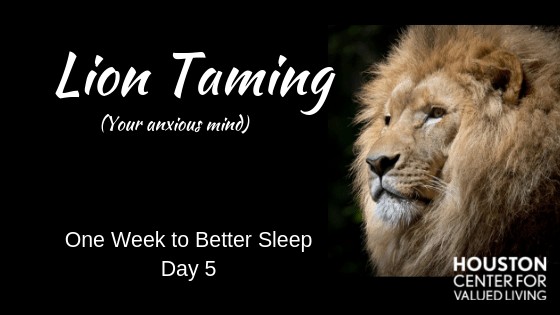This is day 5 of my one week to better sleep series. In Day 5: Lion Taming, we’re going to talk about taming the beast that keeps us all up at night, your mind.
Worry is a normal part of having a human brain. Our brains love problem solving, predicting, and figuring things out. This is really useful at times because it helps us solve and prevent problems.
However, worry is like the unhelpful jerk-brain brother to productive problem solving. Worrying is unproductive. It leads us down rabbit holes of anxiety and fear. We have trouble turning off worry. And the more we worry, the more tense and anxious we feel.
The Lion in Your Bedroom
Tension and anxiety leads to stress. Stress leads to cortisol production. Cortisol production can create an “energetic” response in the body. Too much of that, and we have trouble sleeping. Worry and stress creates this constant “alertness” in our body. Even though we’re tired, we’re tired but wired. It’s like trying to sleep when there’s a lion in the room. Have you ever tried to sleep with a lion in your room? I haven’t either but I can’t imagine I would get any sleep at all.
Is your mind turning your worries into lions? WE NEED TO TAME THOSE LIONS.
The less you sleep, the more you become anxious about your sleep. The less you sleep, the poorer you become at processing and coping with stress during the day. You may find yourself more irritable or feeling emotions more intensely.

Soon, you’re worried about your sleep. Soon, you’re having anxiety about your anxiety. Soon, it’s just a jumbled vicious cycle of worry, fear, and insomnia.
It’s a no brainer that people with insomnia often have anxiety. And that people with anxiety often have insomnia.
So, how do we tame the lions? There are tons of fantastic strategies for coping with worry and anxiety. Below, are 2 simple strategies.
Pre-Bed Problem Solving
A few hours before bed, make a list of three topics that you think your brain might want to start worrying about while you’re lying in bed.
- Worry #1
- Worry #2
- Worry #3
Then, write down what the next logical step would be to resolving that worry. What’s the next course of action? What can you actually do in this situation?
- Next step for worry #1
- Next step for worry #2
- Next step for worry #3
Then, once you’ve written down the next step, you’re all done. At night, when you’re lying in bed and your mind naturally drifts to this topic of worry, remind yourself that in your best, alert, problem solving state of mind, you have already worked out the next logical step. You don’t have to waste any more of your valuable time thinking about this situation because you already know what you’re going to do next.
Example: I’m worried about filing my income tax and what if I do it wrong.
What’s the next step? I’m going to call my CPA at 10am tomorrow and set up a meeting with her.
Great. That’s as far as I can go, and I know I will be taking the next step to handling this problem.
Example: I have so many things to remember this week, what if I forget them?
What’s the next step? I’m going to schedule the items on my phone’s calendar so that I receive daily reminders of when I need to do them.
Wonderful. Again. Remind yourself that you’ve already done the best you can do with this problem. Thinking about it in the middle of the night in a half asleep anxious state is unlikely to produce any productive material.
Thank your Mind
Finally, a favorite technique of mine is asking yourself, “has continuing to think about this worry/concern helped me in any way? Has it gotten me more sleep? Has it made me feel any better? Has it gotten me any closer to a solution?”
If there answer is no, it’s time to thank your mind kindly for its worries (just as you would your annoying unhelpful alarmist advice giving second cousin Mildred), and then refocus your attention on something else, such as the feeling of the pillow under your head. The feeling of sheets against your skin. The feeling of air moving through your nose.
As your mind tries to back-step into the worry again, gently thank your mind for it’s bringing up this worry again, and then refocus your attention on the here and now.
Do you need additional support?
There are so many wonderful cognitive and behavioral strategies for handling worry, anxiety, and fear. If you’d like more help with taming your lions, the Houston Center for Valued Living would like to help you. Reach out to us today about how to schedule an appointment.
We offer “in home sessions” through our telehealth video session platforms. You can access kick butt lion taming therapy from the comfort of your own home or office. Fighting Houston traffic not required. Woohoo! We’d love to hear from you. Call or e-mail us (info@hcfvl.com).
You can access the previous posts here:
Day 1: Stop Sabotaging Your Sleep Drive
Day 2: Is Your Body Confused About When to Sleep?
Day 3: Do I Really Have to Get Up at the Same Time Each Day?

Kathryn Tipton has passion for sleep and wants to help you return to sleeping through the night. She uses Cognitive Behavioral Therapy for Insomnia (CBT-I), a non-pharmacological treatment to help clients gain control over their insomnia and improve the quality of their sleep. She is a Licensed Professional Counselor with a Masters degree in Clinical Psychology. Her private practice is located in central Houston, in the Montrose district. Additionally, she conducts sessions online/via phone with clients from the comfort of their own home or office.

